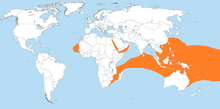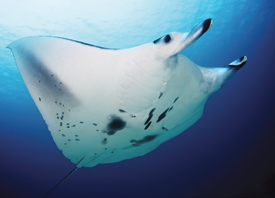Reef manta ray
| Reef manta ray | |
|---|---|

| |
| M. alfredi in the Maldives | |
| Scientific classification | |
| Domain: | Eukaryota |
| Kingdom: | Animalia |
| Phylum: | Chordata |
| Class: | Chondrichthyes |
| Subclass: | Elasmobranchii |
| Superorder: | Batoidea |
| Order: | Myliobatiformes |
| Family: | Mobulidae |
| Genus: | Mobula |
| Species: | M. alfredi
|
| Binomial name | |
| Mobula alfredi (Krefft, 1868)
| |

| |
| Synonyms | |
|
Manta alfredi | |
The reef manta ray (Mobula alfredi)[3] is a species of ray in the family Mobulidae, one of the largest rays in the world. Among generally recognized species, it is the second-largest species of ray, only surpassed by the giant oceanic manta ray.[4]
The species was described in 1868 by Gerard Krefft, the director of the Australian Museum. He named it M. alfredi in honor of Alfred, Duke of Edinburgh, the first member of the British royal family to visit Australia.[5] It was originally described as part of the genus Manta but in 2017 was changed, along with the rest of the mantas, to be included as part of the genus Mobula.[6]
Reef manta rays are typically 3 to 3.5 m (9.8 to 11.5 ft) in disc width,
Description
The reef manta ray can grow to a disc size of up to 5 m (16 ft) but average size commonly observed is 3 to 3.5 m (11 ft).[7][10] It is dorsoventrally flattened and has large, triangular
Physical distinctions between oceanic manta ray and reef manta ray
The first difference could be the size because the giant oceanic manta ray is bigger than the reef manta ray, 4 to 5 m (13–16 ft) on average versus 3 to 3.5 m (9.8–11.5 ft) on average.[7] However, if the observed rays are young, their size can easily bring confusion. Only the color pattern remains a fast and effective way to distinguish them. The reef manta ray has a dark dorsal side with usually two lighter areas on top of the head, looking like a nuanced gradient of its dark dominating back coloration and whitish to greyish, the longitudinal separation between these two lighter areas forms a kind of “Y”. While for the oceanic manta ray, the dorsal surface is deep dark and the two white areas are well marked without gradient effect. The line of separation between these two white areas form meanwhile a "T".
Difference can also been made by their ventral coloration, the reef manta ray has a white belly with often spots between the
Distribution and habitat
The reef manta ray has a widespread distribution in tropical and subtropical parts of the Indo-Pacific, with few records from the warm East Atlantic and none in the West Atlantic or East Pacific.[1] It can be observed in several often-visited regions such as Hawaii, Fiji, French Polynesia, Micronesia, Bali, Komodo, Maldives, Mozambique, Australia and the Philippines.[13] It is primarily found in coastal regions.[1][14]
Reef manta rays live in a more or less identical wide area with the possibility of short migration to follow the zooplankton. They therefore have a relatively sedentary behavior with precise areas for cleaning and feeding still within close proximity of coasts, reefs or islands.[1]
Biology

The reef manta ray has a
Like the Oceanic manta ray, it has the largest brain weight and ratio among cold blooded fish.[15][16] Also, reef manta rays have been confirmed to form social communities in specific populations. [15][16]
In New Caledonia, there are records of reef manta rays diving up to 672m in search of food.[17] It is believed that this allows Reef manta ray to act in the cold deep waters with certain Rete mirabile in the pectoral fins that can act as countercurrent heat. [17]
The reef manta ray, as the oceanic manta ray, is
Status and threats
Natural predation
Because of its large size and velocity in case of danger (24 km/h or 15 mph escape speed),
The reef manta ray is considered to be
-
M. alfredi at a cleaning station, maintaining a near-stationary position on top a coral patch for several minutes while being cleaned by cleaner fish[26]
-
M. alfredi cruising (swimming with cephalic lobes rolled and mouth closed)
-
Foraging M. alfrediram feeding, swimming against the tidal current with its mouth open and sieving zooplankton from the water[26]
-
M. alfredi from Yap, Micronesia
References
- ^ . Retrieved 20 November 2021.
- ^ "Appendices | CITES". cites.org. Retrieved 2022-01-14.
- ^ "Mobula alfredi". FishBase. Retrieved 2019-04-22.
- ^ a b c d e Marshall, Andrea; Compagno, Leonard; Bennet, Michael. "Redescription of the genus Manta with resurrection of Manta alfredi (Krefft, 1868) (Chondrichthyes; Myliobatoidei; Mobulidae)". Zootaxa (2301). Magnolia Press: 1–28. Retrieved 4 May 2014.
- ^ "Alfred Manta, Manta alfredi (Krefft, 1868)". Australian Museum. Retrieved 2016-05-15.
- ^ a b c d "Mantas at a Glance". Manta Trust. Archived from the original on 2013-01-03. Retrieved 2016-05-15.
- ^ a b "Manta Ray Research". Foundation for the Protection of Marine Megafauna. Retrieved 31 May 2012.
- PMID 25337865.
- ^ Marshall, A.D., L.J.V. Compagno and M.B. Bennett, 2009. Redescription of the genus Manta with resurrection of Manta alfredi (Krefft, 1868) (Chondrichthyes; Myliobatoidei; Mobulidae). Zootaxa 2301:1-28.
- ^ "Field guide to the identification of Mobulid rays (Mobulidae)", Guy Stevens, Manta Trust, 2011.
- ^ "Spot the Difference". Manta Trust. Retrieved 2016-05-15.
- ^ "Manta Hotspots". Manta Trust. Archived from the original on 2013-01-27. Retrieved 2016-05-15.
- ^ "Reef manta ray recorded for first time in Eastern Pacific". Discover Wildlife. Retrieved 2023-02-02.
- ^ a b "Manta rays form close friendships, shattering misconceptions". National geo graphic. Archived from the original on April 13, 2021. Retrieved 2021-05-27.
- ^ a b "We Just Learned Manta Rays May Have Surprisingly Close 'Friends' They See Regularly". sciencealert.
- ^ a b "Diving behavior of the reef manta ray (Mobula alfredi) in New Caledonia: More frequent and deeper night-time diving to 672 meters". Retrieved 2021-05-27.
- ^ PMID 20646146.
- PMID 22675137.
- ^ "Manta". Florida Museum of Natural History. Retrieved 11 November 2009.
- ^ "Manta Ray Manta birostris (Donndorff, 1798) in Captivity". Retrieved 2021-05-27.
- ^ "Natural Predation". Manta Trust. Retrieved 2016-05-15.
- ^ Marshall, A.D. and Bennett, M.B. 2010. "The frequency and effect of shark-inflicted bite injuries to the reef manta ray (Manta alfredi)". African Journal of Marine Science 32: 573–580.
- ^ "Manta Fisheries". Manta Trust. Archived from the original on 2013-01-27. Retrieved 2016-05-15.
- ^ "Gill Plate Trade". Manta Trust. Archived from the original on 2016-10-25. Retrieved 2016-05-15.
- ^
External links
- Photos of Reef manta ray on Sealife Collection
- Manta Matcher project at mantamatcher.org


![M. alfredi at a cleaning station, maintaining a near-stationary position on top a coral patch for several minutes while being cleaned by cleaner fish[26]](http://upload.wikimedia.org/wikipedia/commons/thumb/d/de/Manta_alfredi_at_a_%E2%80%98cleaning_station%E2%80%99_-_journal.pone.0046170.g002B.png/371px-Manta_alfredi_at_a_%E2%80%98cleaning_station%E2%80%99_-_journal.pone.0046170.g002B.png)

![Foraging M. alfredi ram feeding, swimming against the tidal current with its mouth open and sieving zooplankton from the water[26]](http://upload.wikimedia.org/wikipedia/commons/thumb/3/33/Manta_alfredi_ram_feeding.png/318px-Manta_alfredi_ram_feeding.png)



